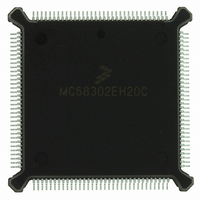MC68302EH20C Freescale Semiconductor, MC68302EH20C Datasheet - Page 220

MC68302EH20C
Manufacturer Part Number
MC68302EH20C
Description
IC MPU MULTI-PROTOCOL 132-PQFP
Manufacturer
Freescale Semiconductor
Datasheets
1.MC68302AG20C.pdf
(4 pages)
2.MC68302AG20C.pdf
(2 pages)
3.MC68302AG20C.pdf
(13 pages)
4.MC68302EH20C.pdf
(481 pages)
Specifications of MC68302EH20C
Processor Type
M683xx 32-Bit
Speed
20MHz
Voltage
5V
Mounting Type
Surface Mount
Package / Case
132-MQFP, 132-PQFP
Family Name
M68000
Device Core
ColdFire
Device Core Size
32b
Frequency (max)
20MHz
Instruction Set Architecture
RISC
Supply Voltage 1 (typ)
5V
Operating Temp Range
0C to 70C
Operating Temperature Classification
Commercial
Mounting
Surface Mount
Pin Count
132
Package Type
PQFP
Lead Free Status / RoHS Status
Lead free / RoHS Compliant
Features
-
Lead Free Status / Rohs Status
Compliant
Available stocks
Company
Part Number
Manufacturer
Quantity
Price
Company:
Part Number:
MC68302EH20C
Manufacturer:
Freescale Semiconductor
Quantity:
10 000
Part Number:
MC68302EH20C
Manufacturer:
FREESCALE
Quantity:
20 000
Company:
Part Number:
MC68302EH20CB1
Manufacturer:
Freescale Semiconductor
Quantity:
10 000
Company:
Part Number:
MC68302EH20CR2
Manufacturer:
Freescale Semiconductor
Quantity:
10 000
- MC68302AG20C PDF datasheet
- MC68302AG20C PDF datasheet #2
- MC68302AG20C PDF datasheet #3
- MC68302EH20C PDF datasheet #4
- Current page: 220 of 481
- Download datasheet (2Mb)
Communications Processor (CP)
sion of a block. For the receiver, the ENQ character designates the end of the block, but no
CRC is expected.
Following control character reception (i.e., end of the block), the RCH bit in the BISYNC
mask register should be set, re-enabling interrupts for each byte of received data.
4.5.14 DDCMP Controller
The byte-oriented digital data communications message protocol (DDCMP) was originated
by DEC for use in networking products. The three classes of DDCMP frames are transparent
(or maintenance) messages, data messages, and control messages (see Figure 4-34).
Each class of frame starts with a standard two octet synchronization pattern and ends with
a CRC. Depending upon the frame type, a separate CRC may be present for the header as
well as the data portions of the frame. These CRCs use the same 16-bit generator polyno-
mial as that used in HDLC.
The most notable feature of the DDCMP frame is that the frame length is transmitted within
the frame itself. Thus, any character pattern can be transmitted in the data field since the
character count is responsible for ending the frame, not a special character. For this to work
properly, the header containing the frame length must be protected, causing a need for a
CRC in the frame header.
The bulk of the frame is divided into fields whose meaning depends on the frame type. De-
fined control characters are only used in the fixed-length frame headers (the fields between
the synchronization octets and the first CRC). The following fields are one byte each: SYN1,
SYN2, SOH, RESP, NUM, ADDR, ENQ, DLE, and FILL. The following fields are two bytes
each: COUNT + F, CRC1, CRC2, and CRC3. The DATA field is a variable number of bytes,
as defined in the COUNT field.
DDCMP communications can be either synchronous or asynchronous, with both types using
the same frame format. Synchronous DDCMP frames require the physical layer to transmit
the clock along with data over the link. Asynchronous DDCMP frames are composed of
asynchronous UART characters, which together form the frame. The receiver and transmit-
ter clocks are not linked; the receiver resynchronizes itself every byte using the start and
stop bits of each UART character.
4-100
TRANSPARENT
DATA MESSAGE FORMAT
CONTROL MESSAGE FORMAT
SYN1
SYN1
SYN1
SYN2
SYN2
SYN2
ENQ
SOH
DLE
Figure 4-34. Typical DDCMP Frames
COUNT
COUNT
MESSAGE TYPE AND SUBTYPE
MC68302 USER’S MANUAL
F
F
RESP
FILL
NUM
FILL
ADDR
ADDR
ADDR
CRC1
CRC1
CRC3
DATA (BYTES)
DATA (BYTES)
CRC2
CRC2
MOTOROLA
Related parts for MC68302EH20C
Image
Part Number
Description
Manufacturer
Datasheet
Request
R
Part Number:
Description:
Manufacturer:
Freescale Semiconductor, Inc
Datasheet:

Part Number:
Description:
MC68302 Configuring the Chip Selects on the MC68302
Manufacturer:
Motorola / Freescale Semiconductor

Part Number:
Description:
MC68302 Design Concept - Expanding Interrupts on the MC68302
Manufacturer:
Motorola / Freescale Semiconductor

Part Number:
Description:
MC68302 MC68302 Adapting a WAN Controller to a LAN Environment
Manufacturer:
Motorola / Freescale Semiconductor

Part Number:
Description:
MC68302 EKB Applications - Power Measurements on the MC68302
Manufacturer:
Motorola / Freescale Semiconductor

Part Number:
Description:
MC68302 Interfacing the MC68020 to a Slave MC68302
Manufacturer:
Motorola / Freescale Semiconductor

Part Number:
Description:
MC68302 MC68302 Software Performance
Manufacturer:
Motorola / Freescale Semiconductor

Part Number:
Description:
MC68302 Evaluating EDX on the ADS302
Manufacturer:
Motorola / Freescale Semiconductor

Part Number:
Description:
MC68302 Design Advisory #1 - MC68SC302 Passive ISDN Protocol Engine
Manufacturer:
Motorola / Freescale Semiconductor

Part Number:
Description:
MC68302, MC68360, and MPC860 Characteristics and Design Notes for Crystal Feedback Oscillators
Manufacturer:
Motorola / Freescale Semiconductor
Part Number:
Description:
Mc68302 Integrated Multi-protocol Processor
Manufacturer:
Freescale Semiconductor, Inc
Datasheet:
Part Number:
Description:
Manufacturer:
Freescale Semiconductor, Inc
Datasheet:
Part Number:
Description:
Manufacturer:
Freescale Semiconductor, Inc
Datasheet:
Part Number:
Description:
Manufacturer:
Freescale Semiconductor, Inc
Datasheet:
Part Number:
Description:
Manufacturer:
Freescale Semiconductor, Inc
Datasheet:











